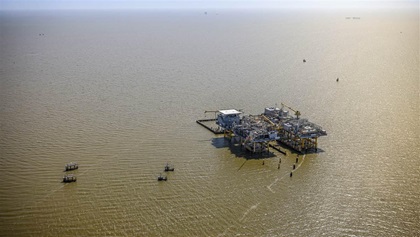Flying to an oil rig
Challenging, and not for the faint of heart

The first Gulf well was drilled off Louisiana in 1938 in less than 15 feet of water. But close-in oil reserves have been depleted. Oil exploration is now out in the Continental shelf, onto the Continental slope, and beyond. Today, the bulk of U.S. production draws from wells in more than one thousand feet of water.
“Flying offshore is a unique experience,” says Lance Panepinto, owner of Panther Helicopters in Belle Chasse, Louisiana. He has weathered the ups and downs of the industry for nearly 45 years. He started Panther with a Robinson R22 flying in all kinds of weather scenarios that the volatile Gulf can stir up. Panther pilots fly as far as 120 miles offshore to smaller, independent oil company rigs, and also deliver pipeline workers to the larger platforms.
The challenge of landing on an oil rig platform is great. “We call 10 minutes out so the activity on the heliport is shut down and ready for us. Then you get the ‘green deck’ permit to land from the production foreman. There could be many reasons you can’t land—there could be a crane on the deck, a boat in the area, or people or other refueling operations. And then there’s methane gas. All operations stop.” The gas is invisible and if a helicopter flies through it, there is the potential for an explosion. Helipads range from 35 feet by 35 feet to 50 feet by 50 feet.
“Flying helicopters here is challenging,” Panepinto said. His pilots fly “14 and 14,” which is two weeks of flying and two weeks off. This is standard across the Gulf. Most of his pilots have more than 3,000 hours and lots of experience flying in the Gulf.
“The Gulf is the second worst area to fly in the U.S.,” he says. (If you’re wondering, Seattle is first.) Louisiana gets fog from cooling water and warm fronts. “The sea fog can get so thick you can’t see the rim of the helipad. You have to wait until the wind blows it away. You have to teach a new guy that he can land on a perfectly clear day, go inside, and eat lunch at the cafeteria on the platform and come out and not be able to leave.”
His helicopters have wind limits—above 35 mph, the pilot can’t shut the blades down or the wind will “knock the back end off; if we’re picking up a guy on a rig, we’ll keep the bird running waiting for him.”

 QUALIFICATIONS: “A pilot who wants to work for me has an instrument rating, 500 helicopter hours, and then 250 hours in make and model; that gets them to 750 hours,” said Panepinto. “Those with offshore experience are the most valuable to me. Right now, there is a demand for pilots and mechanics; I try to make sure this is a good environment, and the benefits are good.”
QUALIFICATIONS: “A pilot who wants to work for me has an instrument rating, 500 helicopter hours, and then 250 hours in make and model; that gets them to 750 hours,” said Panepinto. “Those with offshore experience are the most valuable to me. Right now, there is a demand for pilots and mechanics; I try to make sure this is a good environment, and the benefits are good.”

